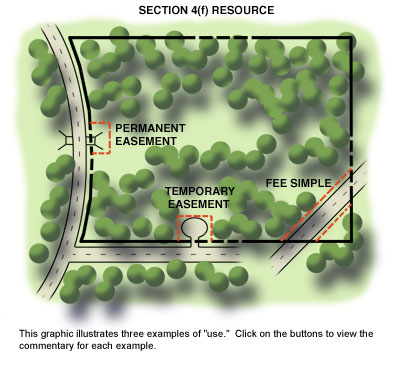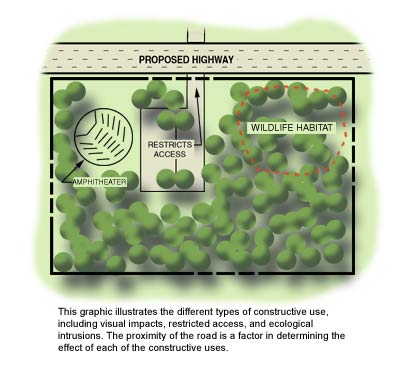Use
TYPES OF USE
There are three main types of use:
This portion of the tutorial will introduce the three main types of use and help you to recognize use in various projects. Additionally, this section will address how a finding of de minimis impact to a Section 4(f) property relates to the definition of use.
Permanent Incorporation
This type of use involves a Right-of-Way (ROW) acquisition of Section 4(f) land as part of a transportation project. In other words, the transportation agency or project sponsor directly purchases the property (fee simple acquisition), and the property sustains a permanent impact—typically, changing from Section 4(f) property to a transportation facility.
Permanent Easement
With this type of use, the transportation agency acquires a permanent easement on the Section 4(f) property for transportation or related purposes. Although the underlying ownership of the land may remain with the original owner, the transportation owner or operator acquires a permanent interest in the use or maintenance of some portion of the property that disrupts its Section 4(f) function. Examples of permanent easement use include maintenance access, utility access, placement of and/or maintenance of drainage features such as stream outfall structures.
Temporary Occupancy
During the construction of a highway project, a temporary occupancy of a Section 4(f) property may be necessary for activities such as regrading slopes or to provide staging or access areas. Depending upon conditions, such activities – even though temporary in nature – may be considered adverse in terms of the Section 4(f) statute’s preservation purpose, and therefore would be considered a Section 4(f) use. Once the easement is no longer needed, the Section 4(f) property must be restored to the condition in which it was originally found. This may involve re-grading or re-vegetating the area.
 |
|
|
Alternate View |
Note: Temporary occupancies may be considered a Section 4(f) use if the land is subject to temporary or permanent adverse changes, such as contour alterations, removal of mature trees and other vegetation, or disruption of facilities or activities on the property. Temporary occupancy is not a Section 4(f) use if all of the following conditions exist:
- The land use is of short duration (defined as less than the time needed for the construction of the project)
- There is no change in ownership of the land
- The scope of the work must be minor
- There are no temporary or permanent adverse changes to the activities, features, or attributes of the property
- The land must be fully restored to a condition at least as good as prior to the project
- There must be documented agreement from the official(s) with jurisdiction over the property with the above conditions
Conditions must be evaluated on a case-by-case basis to determine whether or not a particular activity constitutes use of a Section 4(f) property.
Constructive Use
Constructive use involves an indirect impact to the Section 4(f) property of such magnitude as to effectively act as a permanent incorporation. Here the project does not physically incorporate the resource but is close enough to it to severely impact important features, activities or attributes associated with it, and to substantially impair it.

Constructive use may include impacts such as noise, access restrictions, vibration, ecological intrusions and visual impacts. Note that constructive use does not occur under the following conditions:
- When there is a finding of “No historic properties affected” or “No adverse effect” under Section 106
- When noise resulting from the project does not approach or exceed the FHWA noise abatement criteria or when it is considered a barely perceptible increase over existing levels
- When the final environmental document is approved or ROW is obtained prior to a change in Section 4(f) status of the adjacent property
- When transportation right-of-way is reserved for a future project prior to or at the same time that a Section 4(f) property is established adjacent to the ROW (and the two facilities are planned concurrently)
- When the overall combined impacts do not result in substantial impairment
- When impacts are mitigated to a condition equal to or better than the no-build option
- When a change in accessibility is considered minor
- When vibration impacts are considered minor or mitigated
Constructive use of Section 4(f) land is rare and any potential determination of constructive use should therefore be examined very carefully. Project documents should contain the evaluation of proximity effects and a discussion of whether or not there is substantial impairment to a Section 4(f) property. The term "constructive use" need not be used, except when responding to review comments in environmental documents that specifically address constructive use. In cases where a constructive use determination appears appropriate the FHWA Division Office or Federal Lands Division Office must consult with the FHWA Headquarters Office of Project Development and Environmental Review to make the final determination.
